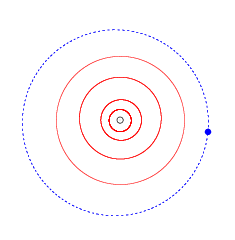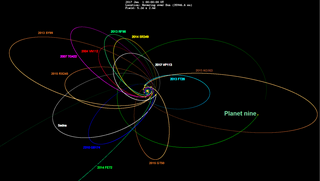Related Research Articles

1998 WW31, is a non-resonant trans-Neptunian object and binary system from the Kuiper belt located in the outermost region of the Solar System, approximately 148 kilometers (92 miles) in diameter. It was first observed on 18 November 1998, by American astronomer Marc Buie and Robert Millis at the Kitt Peak National Observatory in Arizona, United States. In December 2000, a minor-planet moon, designated S/2000 (1998 WW31) 1 with a diameter of 123 kilometers (76 miles), was discovered in its orbit. After Charon in 1978, it was the first of nearly 100 satellites since discovered in the outer Solar System.

53311 Deucalion, provisional designation 1999 HU11, is a trans-Neptunian object from the classical Kuiper belt, with a diameter of approximately 130–210 kilometers (81–130 miles), located in the outermost region of the Solar System. The cubewano belongs to the cold population and was discovered on 18 April 1999, by the Deep Ecliptic Survey at the Kitt Peak National Observatory in Arizona, United States. It was named after Deucalion, from Greek mythology.
(118228) 1996 TQ66, prov. designation:1996 TQ66, is a resonant trans-Neptunian object of the plutino population in the Kuiper belt, located in the outermost region of the Solar System. It was discovered on 8 October 1996, by American astronomers Jun Chen, David Jewitt, Chad Trujillo and Jane Luu, using the UH88 telescope at the Mauna Kea Observatories, Hawaii. The very red object measures approximately 185 kilometers (110 miles) in diameter. As of 2021, it has not been named.
(35671) 1998 SN165, prov. designation: 1998 SN165, is a trans-Neptunian object from the Kuiper belt located in the outermost region of the Solar System. It was discovered on 23 September 1998, by American astronomer Arianna Gleason at the Kitt Peak National Observatory near Tucson, Arizona. The cold classical Kuiper belt object is a dwarf planet candidate, as it measures approximately 400 kilometers (250 miles) in diameter. It has a grey-blue color (BB) and a rotation period of 8.8 hours. As of 2021, it has not been named.
(181902) 1999 RD215 is a trans-Neptunian object of the scattered disc, approximately 148 kilometers in diameter. It was discovered on 6 September 1999, by American astronomers Chad Trujillo, Jane Luu, and David Jewitt at the Mauna Kea Observatories, Hawaii.
(469306) 1999 CD158, provisional designation: 1999 CD158, is a trans-Neptunian object from the circumstellar disc of the Kuiper belt, located in the outermost region of the Solar System. The relatively bright hot classical Kuiper belt object measures approximately 310 kilometers (190 miles) in diameter. It was discovered on 10 February 1999, by American astronomers Jane Luu, David Jewitt and Chad Trujillo at Mauna Kea Observatories on the Big Island of Hawaii, United States.
(589683) 2010 RF43, provisionally designated: 2010 RF43, is a large trans-Neptunian object orbiting in the scattered disc in the outermost regions of the Solar System. The object was discovered on 9 September 2010, by American astronomers David Rabinowitz, Megan Schwamb and Suzanne Tourtellotte at ESO's La Silla Observatory in northern Chile.
1999 TR11, is a resonant trans-Neptunian object from the Kuiper belt, located in the outermost region of the Solar System. The reddish plutino measures approximately 93 kilometers (58 miles) in diameter. It was first observed on 9 October 1999, by American astronomer Scott Sheppard at the Mauna Kea Observatories with the University of Hawaii's 2.2-meter telescope.
(523671) 2013 FZ27, provisional designation 2013 FZ27, is a trans-Neptunian object located in the Kuiper belt in the outermost region of the Solar System, approximately 570 kilometers (350 miles) in diameter. It was discovered on 16 March 2013, by American astronomers Scott Sheppard and Chad Trujillo at the CTIO in Chile. Numbered in 2018, this minor planet has not been named.
(523645) 2010 VK201, provisional designation 2010 VK201, is a trans-Neptunian object and member of the classical Kuiper belt, approximately 500 kilometers (310 miles) in diameter. It was discovered on 1 November 2010, by the Pan-STARRS 1 survey at Haleakala Observatory, Hawaii, United States. It has a rotation period of 7.6 hours. It was numbered in September 2018 and remains unnamed.
2011 KW48, temporarily designated VNH0004, is a trans-Neptunian object from the inner classical part of the Kuiper belt, located in the outermost region of the Solar System. It measures approximately 77 kilometers (48 mi) in diameter.
420356 Praamzius, provisional designation 2012 BX85, is a trans-Neptunian object from the classical Kuiper belt, located in the outermost region of the Solar System, approximately 190–320 kilometers (120–200 miles) in diameter. It was discovered on 23 January 2012, by astronomers Kazimieras Černis and Richard Boyle with the Vatican's VATT at Mount Graham Observatory in Arizona, United States. The cold classical Kuiper belt object is a weak dwarf planet candidate and possibly very red in color. It was named after the chief god Praamžius from Lithuanian mythology.

(523794) 2015 RR245, provisional designation 2015 RR245, is a large trans-Neptunian object of the Kuiper belt in the outermost regions of the Solar System. It was discovered on 9 September 2015, by the Outer Solar System Origins Survey at Mauna Kea Observatories on the Big island of Hawaii, in the United States. The object is in a rare 2:9 resonance with Neptune and measures approximately 600 kilometers in diameter. 2015 RR245 was suspected to have a satellite according to a study announced by Noyelles et al. in a European Planetary Science Congress meeting in 2019.

2015 RX245 is an extreme trans-Neptunian object, detached, on a highly eccentric orbit in the outermost region of the Solar System. It measures approximately 250 kilometers (160 miles) in diameter and is "possibly" a dwarf planet. It was first observed on 8 September 2015, by astronomers with Outer Solar System Origins Survey using the 3.6-meter Canada–France–Hawaii Telescope at Mauna Kea Observatories, Hawaii, in the United States.
(505478) 2013 UT15 is an extreme trans-Neptunian object from the scattered disc, located in the outermost regions of the Solar System, approximately 260 kilometers (160 miles) in diameter. It was discovered on 2 August 2013, by astronomers of the Outer Solar System Origins Survey at Mauna Kea Observatory, Hawaii, United States.
(523674) 2013 MA12, provisional designation 2013 MA12, is a classical trans-Neptunian object and dwarf planet candidate from the Kuiper belt, located in the outermost region of the Solar System, approximately 340 kilometers (210 miles) in diameter. The cubewano belongs to the hot population. It was discovered on 26 July 2011, by astronomers with the Pan-STARRS survey at Haleakala Observatory, Hawaii, United States.
(523702) 2014 HW199, provisional designation 2014 HW199, is a trans-Neptunian object from the classical Kuiper belt, located in the outermost region of the Solar System. It was discovered on 30 January 2011, by astronomers with the Pan-STARRS survey at Haleakala Observatory, Hawaii, United States. The classical Kuiper belt object is also a dwarf planet candidate, as it measures approximately 290 kilometers (180 miles) in diameter.
(523684) 2014 CQ23, provisional designation 2014 CQ23, is a trans-Neptunian object and cubewano from the Kuiper belt, located in the outermost region of the Solar System. It was discovered on 13 March 2011, by astronomers with the Pan-STARRS survey at Haleakala Observatory, Hawaii, United States. The classical Kuiper belt object belongs to the hot population and is a dwarf planet candidate, as it measures approximately 330 kilometers (210 miles) in diameter.
(523687) 2014 DF143, provisional designation 2014 DF143, is a trans-Neptunian object and cubewano from the Kuiper belt, located in the outermost region of the Solar System. It was discovered on 12 April 2011, by astronomers with the Pan-STARRS survey at Haleakala Observatory, Hawaii, United States. The classical Kuiper belt object belongs to the hot population and is a dwarf planet candidate, as it measures approximately 350 kilometers (220 miles) in diameter.
(505624) 2014 GU53, provisional designation 2014 GU53, is a trans-Neptunian object and cubewano from the Kuiper belt, located in the outermost region of the Solar System. It was discovered on 8 April 2014, by astronomers with the Pan-STARRS survey at Haleakala Observatory, Hawaii, United States. The classical Kuiper belt object belongs to the hot population and is a dwarf planet candidate, as it measures approximately 330 kilometers (210 miles) in diameter.
References
- 1 2 3 4 5 6 7 "505448 (2013 SA100)". Minor Planet Center. Retrieved 2 December 2018.
- 1 2 3 4 5 6 Pike, Rosemary E.; Fraser, Wesley C.; Schwamb, Megan E.; Kavelaars, J. J.; Marsset, Michael; Bannister, Michele T.; et al. (September 2017). "Col-OSSOS: z-Band Photometry Reveals Three Distinct TNO Surface Types". The Astronomical Journal. 154 (3): 8. arXiv: 1708.03079 . Bibcode:2017AJ....154..101P. doi: 10.3847/1538-3881/aa83b1 . S2CID 3522138.
- 1 2 3 4 5 "JPL Small-Body Database Browser: 505448 (2013 SA100)" (2017-08-30 last obs.). Jet Propulsion Laboratory . Retrieved 2 December 2018.
- 1 2 3 4 5 Johnston, Wm. Robert (7 October 2018). "List of Known Trans-Neptunian Objects". Johnston's Archive. Retrieved 1 December 2018.
- 1 2 3 4 5 Brown, Michael E. "How many dwarf planets are there in the outer solar system?". California Institute of Technology . Retrieved 1 December 2018.
- ↑ "MPC/MPO/MPS Archive". Minor Planet Center. Retrieved 2 December 2018.
- ↑ "LCDB Data for (505448)". Asteroid Lightcurve Database (LCDB). Retrieved 2 December 2018.